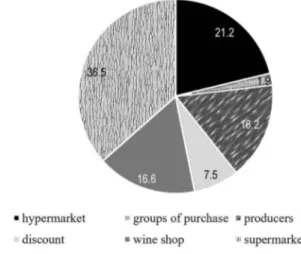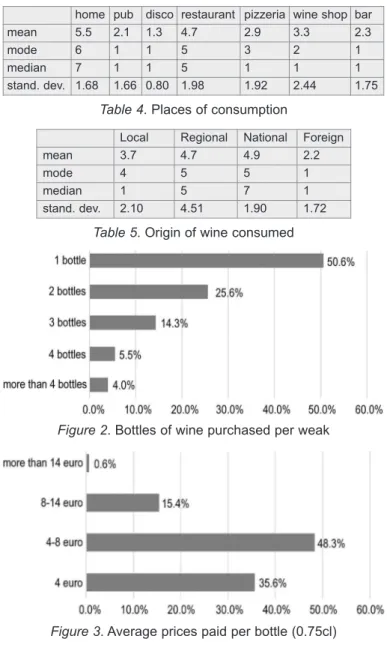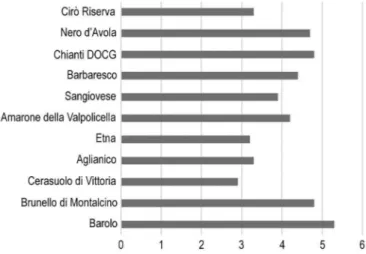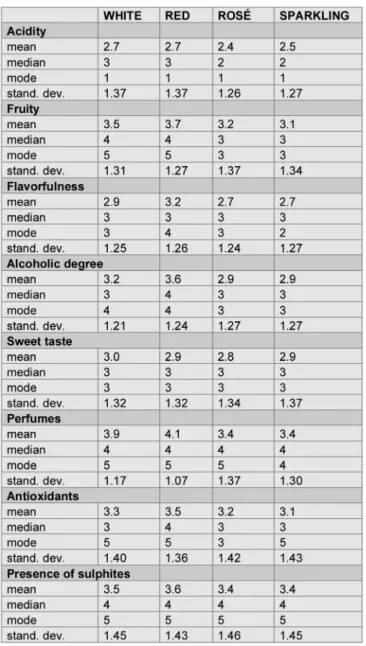FOOD SAFETY MANAGEMENT
1. Introduction
The wines of southern Italy have experienced an unpre-cedented development in the last two decades, as a result of the great importance that these products have acquired on the domestic and international markets (Caracciolo et al., 2015; Di Vita et al., 2015). Alongside traditionally renowned regions, such as Sicily and Apulia, Calabrian wines have entered important market segments, especially niches. Calabria is the fifteenth Italian region in terms vine growing surfaces, with 10,300 hec-tares that represent about 2% of Italian vineyards. In Calabria, the domestic market absorbs about 70% of regional wine production while the rest is marketed on the national market (ISTAT, 2017).
Despite there being a consolidated phenomenon of the so-called ‘regionalization of wine consumption’, there are the conditions for expansion on the domestic and foreign markets. Currently, exports of Calabrian wines to the main international markets are severely limited and there is no particular commer-cial performance even in emerging markets (Dal Vecchio et al., 2018).
After decades of stagnation and immobility, in recent years the actions of some winemakers have gradually revitalised the sector, especially thanks to the generational change that has characterized the small and medium enterprises in the sector.
In this sense, the adoption of specific EU policies, by means of the Rural Development Programs, could certainly lead to an improvement of marketing strategies and communication, taking a chance on sustainable performances of agriculture and the presence of an importance heritage of biodiversity in terms of
ancient local grape varieties (Falcone et al., 2015; 2016). Calabrian wines have acquired a growing importance in the Italian wine scenario, with a growing importance for the territorial economy and the environmental sustainability (Strano et al., 2013; D'Amico et al., 2014; Borsellino et al., 2016; Pellicanò and De Luca, 2016). Based on this premise, this study is a pre-liminary survey about the attitudes of consumers of Calabrian wine.
The present study is organized in 4 sections: the first one presents the main characteristics of wine consumption in Calabria (frequencies, places of purchase and methods of consumption); the second section analyses the importance that consumers give to wines certifications (PDO, PGI, organic, etc.); the third section is about the intrinsic and extrinsic attributes that matter for consumers in the choice of a wine.
2. Data collection and methods
The survey on the consumption of Calabrian wine in Italy was conducted in the period between October and December 2016, in two different areas of northern Italy, in particular in the metropolitan areas of Milan and Turin.
The questionnaires were submitted to 327 interviewees: 160 in Milan and 167 in Turin. In both areas, the interviews were carried out with the face-to-face mode.
The questionnaire was structured with either closed and open-ended questions to gather qualitative and quantitative information on the socio-economic and cultural background of interviewees, their behaviour in the purchase phases and how it
The Attitudes of Calabrian Wine Consumers: A Preliminary Survey
Giacomo FALCONE
1, Bruno Francesco NICOLÒ
1, Nathalie IOFRIDA
1*,
Francesco Saverio NESCI
2, Teodora STILLITANO
1, Giovanni GULISANO
21Researcher in Agricultural Economics and Policy, AGRARIA Department – Mediterranean University of Reggio Calabria;
address: Feo di Vito, 89122 Reggio Calabria, Italy
E-mail: [email protected]; [email protected]; [email protected]; [email protected]
2Full Professor in Agricultural Economics and Policy, AGRARIA Department – Mediterranean University of Reggio Calabria;
address: Feo di Vito, 89124 Reggio Calabria, Italy; E-mail: [email protected]; [email protected]
*To whom correspondence should be addressed
Abstract
The wines of southern Italy have experienced an unprecedented development in the last two decades, especially Calabrian wines that have entered interesting niches of the market. In Calabria, the domestic market absorbs about 70% of regional wine production while the rest is marketed on the national market. Exports of Calabrian wines to the main international markets are severely limited and there is no particular commercial performance even in emerging markets. This study is a preliminary survey about the attitudes of consumers of Calabrian wine. It is organized in 4 sections: the first one presents the main characteristics of wine consumption in Calabria (frequencies, places of purchase and methods of consumption); the second section analyses the importance that consumers give to wines certifications; the third section is about the intrinsic and extrinsic attributes that matter for consumers in the choice of a wine.
Keywords: calabrian wine; wines certifications; protected designation of origin (PDO); protected geographical indication
FOOD SAFETY MANAGEMENT
was influenced by the characteristics of commercial distribution, on their perception of the quality and price of a product, and further opinions linked to the consumption phase. Interviewees were asked to express their preferences with a scale of intensity going from very strong interest (7) to very low interest (1). The questionnaires were submitted at those hypermarkets (mass distribution circuits), in Turin and Milan, with the greatest afflu-ence of purchasers of agri-food produces.
Questions with multiple-choice answers were coded to help interviewees choosing quickly the answers more suitable to their opinion or behaviour. Moreover, almost all the questions were articulated through the predisposition of Likert scales.
The questionnaire was divided into six sections. The first part of the questionnaire was aimed at measuring the frequency of purchase and consumption of wine, taking into account the places of purchase and consumption methods.
The second part focused on the levels of perception, prefe-rences and attitudes towards certified wines – such as wines with Protected Designation of Origin (PDO) or Protected Geographical Indication (PGI) labels, and wines made from grapes from organic, integrated and biodynamic agriculture.
The third section of the questionnaire was aimed at detecting the significance and the level of importance assigned to the intrinsic and extrinsic attributes of wines and at verifying the knowledge about the main Italian and Calabrian wines.
The last part of the survey aimed to identify the socio-economic characteristics of the consumers interviewed.
Data were processed through univariate statistical analyses carried out by calculating mean, medians, mode and standard deviation.
3. Results
In order to outline the characteristics and patterns of wine consumption behaviour, data were firstly processed through simple descriptive statistical analyses (mean, mode, median and standard deviation). The socio-economic characteristics of the sample examined (327 units) are reported below (tab. 1).
Wine consumption is strongly diffused in the area examined, although purchases are made with some regularity by only 67% of respondents, while for the remaining part of the sample con-sumption appears rather sporadic.
Concerning distribution channels (Figure 1), wine purchases
are mainly made in supermarkets and, to a slightly lesser extent, in hypermarkets, confirming the main role of the large-scale retailing. Nonetheless, the purchases made from wine shops and producers are quite significant, as they represent more than 32% of the sample. This phenomenon confirms that consumers prefer a direct contact with the retailer or with the producer himself, to get more information about the wine purchased.
Concerning the frequency of wine purchases (Tab. 2), this has been divided according to the main categories of products on the market: certified wines (PDO, PGI, DOCG) and ordinary wines. The highest purchase frequency is for certified wines, in particular for DOCG wines and PDO wines, while ordinary wines do not seem to represent a particularly appreciated category, regardless of the type of packaging (glass, boxes or bulk).
Among the consumers interviewed, the habit of drinking wine during main meals is very diffused, with dinner as the most suitable moment of the day for the interviewees. The moments of consumption during the morning or evening aperitif are not significant, probably because among the interviewees the num-ber of young people is relatively low; in fact, this habit is more diffused among young people.
As expected, the most frequent places of consumption are those where the main meals are consumed, i.e. home and restaurants; in all other places the consumption of wine is not so widespread, probably because of the specific target of consumers, considering that the surveys were carried out at large organized distribution networks (Tab. 4).
Finally, concerning the origin of the wine, the quantity of bottles consumed, and the average price paid per item, results are shown in table 5 and figures 2 and 3. As reported in the table, the interviewees declared that they prefer to consume Category Variable Number Percentage
gender female 147 45 male 180 55 age (classes) 18-30 74 22.6 31-45 110 33.6 46-60 94 28.7 > 60 49 15.0 education Primary-middle school 43 13.1 High school 123 37.6 University 134 41.0 Post graduate 27 8.3 Average monthly income (Euro) < 1,000 16 4.9 1,000-2,000 109 33.3 2,000-4,000 102 31.2 > 4,000 30 9.2 No answer 70 21.4 Total 327 100
Table 1. Socio-economic characteristics of the sample
Figure 1. Places of purchase (%)
DOCG DOP IGP ordinaryboxes ordinaryglass ordinarybulk mean 3.9 3.8 3.5 1.8 3.0 2.5
mode 4 4 4 1 3 1
median 1 5 1 1 1 1
stand. dev. 2.11 1.98 1.98 1.42 2.00 1.90 Table 2. Consumption frequency per wine category
Brunch Aperitif Pranzo Happy hour Dinner mean 1.7 3.2 3.7 3.5 5.5
mode 1 3 4 3 6
median 1 1 1 1 7
stand. dev. 1.3 2.1 2.1 2.2 1.7 Table 3. Times of the day with high frequency
FOOD SAFETY MANAGEMENT
Italian wines – instead of foreign ones, and they buy an average of one bottle per week (50% of the sample) in a price range between 4 and 8 euros (48% of interviewees).
Regarding certified wines, the interviewees showed having a
good knowledge of the main labels of certifications available on the market; a large part of the sample, i.e. 63.3%, claimed to know PDO and organic wines, while for PGI wines the level of knowledge was slightly lower (56.9%). A limited part of the sample (30%) knew some particular production methods, i.e. integrated and biodynamic farming (Figure 4).
Then, interviewees were asked which process, product and environmental certifications they considered important for a wine. Also in this case, the origin of the wine was the most renowned, with DOCG, DOC and PGI certifications with the highest level of consideration (Tab. 6). Less significant but still appreciable was also the interest towards the certification of the organic production method. The other forms certifications, such as environmental sustainability of production processes, energy saving, fair trade marks, etc., obtained little or no significance for interviewees.
Finally, the questionnaire investigated those aspects related to consumers' environmental consciousness in order to identify their possible propensity to purchase products made with a limi-ted impact on the environment (Tab.7).
In general, it emerged a fair environmental awareness of the interviewees. Personal health was perceived as a priority moti-vation, followed by the preservation of the environment, more at a global scale than at the local one. This result seems to confirm the emergence of a twofold, only apparently antithetical, motiva-tional component, partly linked to the individual sphere and partly environmental conscious.
home pub disco restaurant pizzeria wine shop bar mean 5.5 2.1 1.3 4.7 2.9 3.3 2.3
mode 6 1 1 5 3 2 1
median 7 1 1 5 1 1 1
stand. dev. 1.68 1.66 0.80 1.98 1.92 2.44 1.75 Table 4. Places of consumption
Local Regional National Foreign mean 3.7 4.7 4.9 2.2
mode 4 5 5 1
median 1 5 7 1
stand. dev. 2.10 4.51 1.90 1.72 Table 5. Origin of wine consumed
Figure 2. Bottles of wine purchased per weak
Figure 3. Average prices paid per bottle (0.75cl)
Figure 4. Level of knowledge about wine production
methodologies and labels (%)
DOC DOCG IGT Organic Integrated Biodinamic Environmentalsustainability Energysaving Fairtrade mean 5.2 5.3 4.7 4.4 3.3 2.9 3.4 3.3 3.9
mode 5 6 5 5 3 3 3 3 4
median 7 7 5 7 1 1 1 1 1
stand.
dev. 1.67 1.71 4.25 2.03 1.92 1.91 1.93 1.96 2.07
Health Localenvironment Globalenvironment mean 4.7 4.2 4.4
mode 5 4 4
median 7 4 7 stand. dev. 1.90 1.98 1.98 Table 6. Level of importance of different typologies of wine certifications low environmental impacts productsTable 7. Motivations for purchasing
rosé wine red new red sparkling red full-bodies white dry white sparkling sweet wines
mean 3.1 3.8 3.7 4.7 3.9 4.1 3.8
mode 3 4 4 5 4 4 4
median 1 4 1 6 5 5 1
stand. dev. 1.83 1.85 1.94 1.90 1.95 1.86 2.01 Table 8. Willingness to purchase environmental sustainable wines
The so-called "sustainable wines" include wines produced according to the criteria of sustainable viticulture and, to a lesser extent, organic wines. Consumers were asked their preference
concerning different production techniques and wine aging. Environmental friendly full-bodied red wines represented the most preferred typology, followed by white sparkling wines.
The third section of the questionnaire explored the attitudes
FOOD SAFETY MANAGEMENT
perceptions.
Body, taste and flavours are the most appreciated charac-teristics, while regarding the colour, red wine appears on average the most appreciated.
The general level of appreciation for extrinsic attributes appears slightly lower than for intrinsic characteristics. The price is one of the most influencing characteristics, followed by the
certification of geographical origin, the reputation of the produ-cer and the use of local grape varieties. The other attributes, such as labelling and organic certification, play an important but secondary role (Tab. 10).
The analysis investigated the preferences of interviewees about the main varieties used for the production of red and white wines (Figure 5), using a scale going from most preferred (7) to least preferred (1). Only 52% of the sample admitted to know the name of the grape varieties used for the production of a red or white wine. These results showed that only four varieties are the best known to the interviewees, i.e. Barbera, Nebbiolo, Dolcetto and Nero d'Avola, followed by Merlot, Cabernet and some Italian varieties widely used in the central-northern regions such as Sangiovese and Montepulciano d'Abruzzo.
The Calabrian grape Gaglioppo was the less known, confir-ming how Calabrian wines just occupy particular niches of market. body taste acidity flavours white red rosé
mean 4.9 5.2 3.6 4.6 3.7 4.6 3.4
mode 5 5 4 5 4 5 3
median 5 5 4 5 4 6 4
stand. dev. 1.60 1.42 1.81 1.69 1.85 1.86 1.85 Table 9. Preferences about the intrinsic characteristics of wine
producer localvarieties internationalvarieties certificationof origin organiccetification packaging lowimpacts price label prizes mean 4.7 4.5 3.7 4.8 4.2 3.4 4.1 5.1 4.4 3.1
mode 5 5 4 5 4 4 4 5 5 3
median 5 6 4 5 5 1 4 5 5 1
stand. dev. 1.83 1.79 1.68 1.72 1.89 1.82 1.88 1.59 1.85 1.91 Table 10. Extrinsic attributes of wine
Concerning white grapes (7: most preferred, 1: least pre-ferred), the best appreciated are the following varieties, in descending order (Fig. 6): Prosecco, Chardonnay and Muller Thurgau. Concerning the grape variety grown in Calabria, Greco, it had in a medium-low position, although it is more famous than its red counterpart (Gaglioppo).
Figure 7 below shows the levels of appreciation for some of the most renowned and prestigious Italian wines (7: most appreciated, 1: least appreciated), which are higher for Barolo, Brunello di Montalcino and Chianti. Southern wines are less renowned, that is quite normal, as the interviewees are from northern Italy.
Finally, table 11 shows the results about the perceptions of di-fferent winemaking methods: red, white, rosé and sparkling wine. Overall taste, fruity taste, flavour, alcohol content and aro-mas, and the presence of antioxidants appeared to be the pre-dominant prerogatives of red wines and to a lesser extent of white wines, while only the attribute "acidity" had a higher re-lative frequency among white wines. There are no significant differences between rosé wines and sparkling wines, which represent wines with less sensory appeal. With regard to the potential effects on the health of the consumer, red wine is con-sidered to be the richest in antioxidants, while rosé wines are perceived as the least gifted ones. Finally, concerning the per-ceptions about the presence of sulphites, the data obtained show almost similar results for all four categories of wine considered.
Figure 5. Average preferences about red grapes varieties
Figure 6. Average preferences of white grapes varieties
Figure 7. Levels of appreciations for the most renowned
FOOD SAFETY MANAGEMENT
4. Conclusions
The general objective of this study about the consumption of Calabrian wines was to investigate the interest of consumers in this product, and to identify any potential for development for the Calabrian wine industry in the national market.
In general, the survey highlighted the great importance attri-buted to the geographical origin of wine, which has a much greater impact than other variables. Factors such as certification of origin are considered a priority when choosing a wine.
Overall, there is a good environmental awareness among the interviewees. Personal health benefits are perceived as a
priority motivation, although there is also a slight tendency to preserve the environment more on a global scale than in the local area alone.
Concerning Calabrian production, the local varieties Gagli-oppo and Greco are less known to consumers in northern Italy, while the Cirò PDO seems to have a fair level of notoriety and reputation.
Moreover, the red wine is confirmed as the most appreciated in terms of taste, aromas, flavour, alcohol content and aromas, and is also considered the type of product with the highest antioxidant potential.
Further research and more refined analyses seem to be necessary to better define the degrees of correlation between the different variables examined.
References
[1] Borsellino, V., Migliore, G., D’Acquisto, M., Di Franco, C. P., Asciuto, A., & Schimmenti, E. (2016). ‘Green’Wine through a Responsible and Efficient Production: a Case Study of a Sustainable Sicilian Wine Producer. Agriculture and Agricultural
Science Procedia, 8, 186-192.
[2] Caracciolo, F., Di Vita, G., Lanfranchi, M., D'Amico, M. (2015). Determinants of Sicilian Wine Consumption: Evidence from a Binary Response. American Journal of Applied Sciences 12(11): 794-801.
[3] Dal Vecchio, A., Massaglia, S., Merlino, V. M., Borra, D., & Hao, M. (2018). Italian wines in China’s e-commerce market: focus on Piedmont region products. Italian Journal of Food Science, 30(2). [4] D'Amico, M., Di Vita, G., Chinnici, G., Pappalardo, G., Pecorino, B. (2014). Short food supply chain and locally produced wines: factors affecting consumer behavior. Italian Journal of Food
Science, 26(3), 329-334.
[5] Di Vita G., Caracciolo F., Cembalo L., Pomarici E., D’Amico M. (2015). Drinking wine at home: hedonic analysis of Sicilian wines using quantile regression. American Journal of Applied Sciences 12(10):679-688.
[6] Di Vita, G., Chinnici, G., Pappalardo, G., D'Amico, M., & Bracco, S. (2014). Standard output versus standard gross margin, a new paradigm in the EU farm economic typology: what are the implications for wine-grape growers? Journal of Wine Research, Vol. 25, No. 4, 229-242
[7] Falcone G., De Luca A. I., Stillitano T., Strano A., Romeo G., Gulisano G. (2016). Assessment of environmental and economic impacts of vine-growing combining life cycle assessment, life cycle costing and multicriterial analysis, Sustainability, 8(8):793. [8] Falcone G., Strano A., Stillitano T., De Luca A. I., Iofrida N.,
Gulisano G. (2015). Integrated Sustainability Appraisal of Wine-growing Management Systems through LCA and LCC Methodologies, Chemical engineering transactions, 44: 223-228. [9] Pellicanò A., De Luca A. I. (2016). Dynamics, motivations and
barriers in internationalisation processes of wineries in Calabria,
Journal of wine research, 27: 257-283.
[10] Strano A, De Luca A. I., Falcone G., Iofrida N., Stillitano T., Gulisano G. (2013). Economic and environmental sustainability assessment of wine grape production scenarios in Southern Italy,
Agricultural Sciences, 4(5B):12-20.
Table 11. Flavours taste comparison between different types



